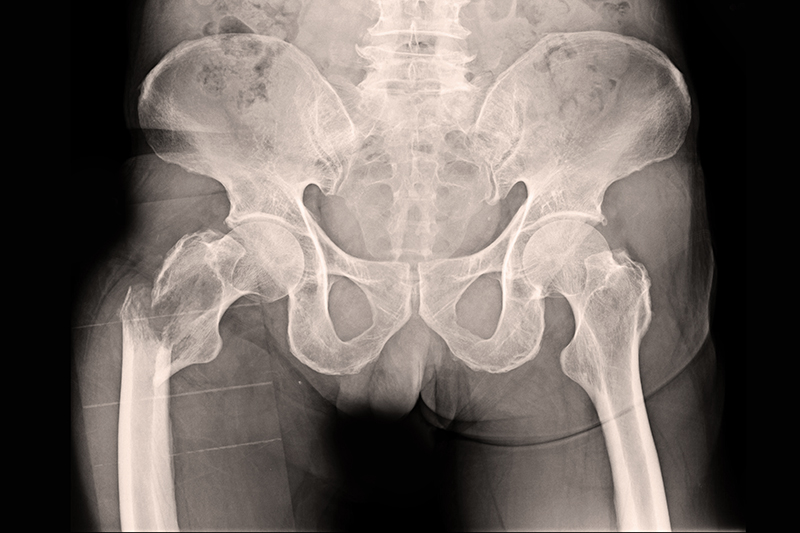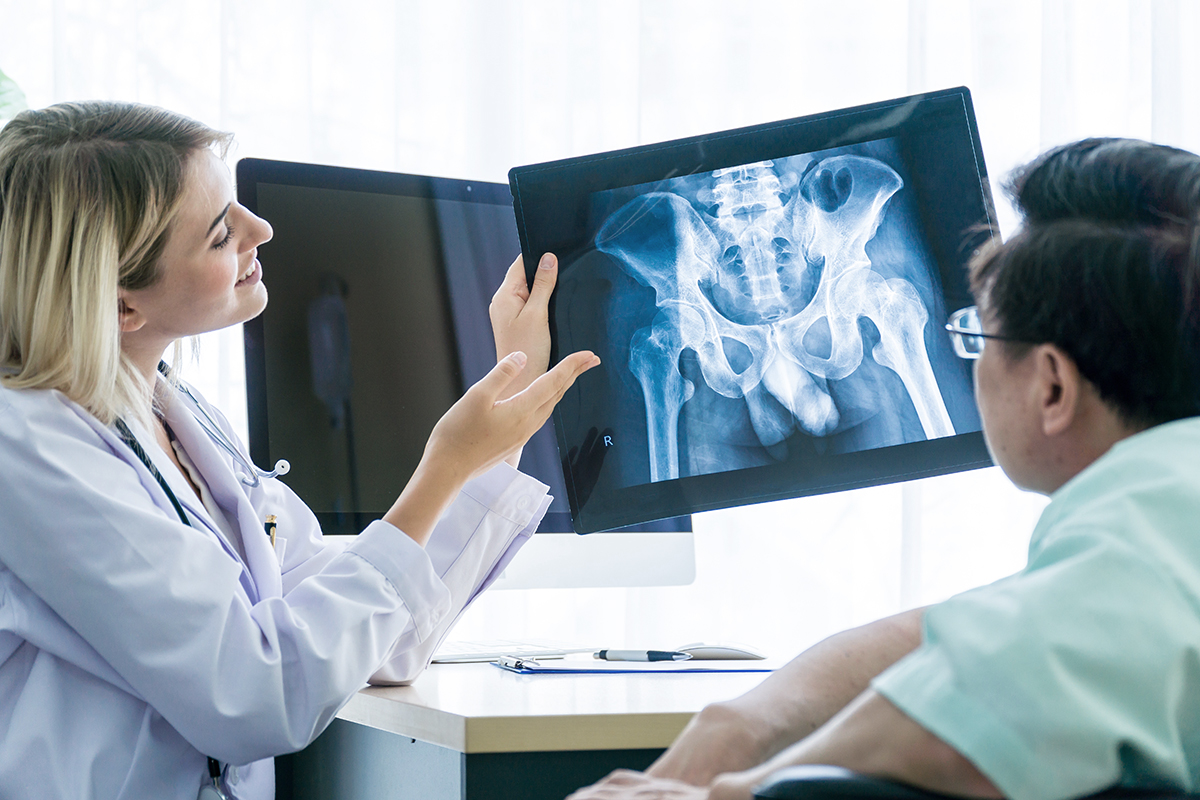Understanding Hip Fractures
Hip fractures refer to the breaking of the upper part of the thigh bone that connects to the pelvic bone, often occurring in the elderly, especially in postmenopausal women or those in menopause, with a chance of 1 in 7 women of this age group experiencing it. It can also happen to both males and females. Currently, the number of people over 60 years old has increased, and in the future, the proportion of the elderly population to the working-age population will rise. Therefore, the chance of having a hip fracture will multiply, which is easy for the elderly to fracture from falls.
The elderly, according to the Thai Elderly Act of 2003, are those aged over 60, similar to the United Nations’ definition, but some countries like the United States set the age at over 65. From the Thai Elderly Situation Report 2009 by the Thailand Research and Development Institute for the Elderly, studying the size and trends of the elderly population in Thailand since 1960, it was found that the population aged 60 and over was only 1.5 million people, or about 5.4% of the total population. But the size of the population aged 60 and over increased sevenfold, approximately 7.6 million people, making 2009 the year that Thailand fully entered an aged society, which is over 10% of the total population. The size and proportion of the elderly population in Thailand continue to rise. By 2025, or in the next 15 years, the number of elderly will increase to 14.9 million people, doubling from 2009, and in 2030 will increase to 17.8 million people, accounting for 25% of the entire national population.
Impacts of Hip Fractures
Although current healthcare technology and surgical treatments for hip fractures can ensure good bone bonding, patients still need to undergo physical therapy for a period. Some patients, who before the fracture could take care of themselves, now require close family members or caregivers to assist them all the time after the hip fracture. Some need to stay in rehabilitation centers, and over half need to use walking aids, such as canes, permanently. Importantly, elderly people with hip fractures have a higher risk of mortality compared to those without fractures, and there are also many complications that can lead to death.
Risk Factors for Hip Fractures
Statistics and research data show that there are risk factors for hip fractures, including:
- Age: The risk increases with age, especially over 65 years old.
- Gender: Women are three times more likely to suffer from fractures than men.
- Genetics: Having a family history of elderly fractures or individuals with small bone structures or slim physique.
- Nutritional status: Individuals with low calcium intake or poor absorption.
- Personal habits: Especially smoking and drinking alcohol.
- Physical impairments: Weak body, arthritis, osteoporosis, poor balance, poor vision.
- Mental impairments: Such as brain diseases, dementia, Alzheimer’s.
- Certain medications: Some medications weaken muscles, cause dizziness, or side effects from drugs or chemicals that affect bones, leading to fractures, including more than just hip fractures, but also spinal and wrist fractures at the ends of the long bones.
Why Do Hip Fractures Occur?
In reality, the upper part of the thigh bone or the hip bone is very strong. However, due to aging, certain illnesses, and medications, osteoporosis can occur, leading to easy fractures. Bones are living tissue composed of protein and calcium capable of self-regeneration, and the body uses calcium from bones all the time. If there is an imbalance, the body doesn’t get enough calcium, which can make bones weak or porous and brittle. Bones start to lose their balance from the age of 35, especially during menopause due to the lack of estrogen hormone. Even though using estrogen hormones during this period can prevent or delay osteoporosis, consulting an obstetrician-gynecologist before taking any supplement is advisable.
Understanding Osteoporosis
Osteoporosis is a condition where bone mass decreases, leading to thinning due to the imbalance of calcium in bones. Osteoporosis is a silent threat as there are no symptoms until a fracture occurs. Although the exact cause cannot be pinpointed, there are risk factors that can lead to osteoporosis.
Osteoporosis Risk Factors
Risk factors for osteoporosis include:
- Old age
- Sedentary lifestyle
- Lack of exercise
- Lack of estrogen hormone
- Use of steroids or thyroid treatment medications
- Alcohol consumption or smoking
- Genetics
Treating Osteoporosis
While it’s impossible to stop osteoporosis, it’s preventable and diagnosable early on. Being attentive and starting early treatment can help delay or reduce complications. If a fracture occurs, treatment options include surgery and comprehensive post-surgical care based on current advancements, aiming for a quick patient recovery, preventing complications, and avoiding repeated fractures. Also, certain nutrients, such as calcium, vitamin D, and regular exercise, are crucial in preventing osteoporosis.
- Calcium: The amount of calcium the body needs varies by age and physical condition, as follows:
-
- Ages 9 – 18 years old require 1,300 milligrams per day
- Ages 19 – 50 years old require 1,000 milligrams per day
- Pregnant and breastfeeding women require 1,000 – 1,300 milligrams per day
- Ages over 50 require 1,200 milligrams per day
Foods high in calcium include green leafy vegetables like kale and broccoli, dairy products, canned sardines with bones, small fish with bones, dried shrimp, firm tofu, black sesame, and shrimp paste.
- Vitamin D: Helps in the absorption of calcium. The body requires 200 – 600 units of vitamin D daily. One glass of milk provides 100 units of vitamin D and 300 milligrams of calcium. If you think your diet does not supply enough calcium and vitamin D, consult a doctor or pharmacist regarding supplements or multivitamins.
Osteoporosis Medications
There are several groups of medications used to treat osteoporosis, depending on what is appropriate for each case. It is important to consult a doctor before using any of these medications to ensure they are suitable. Additionally, it is necessary to reduce or quit drinking alcohol and smoking, be cautious to prevent falls due to poor balance, lack of exercise, or dizziness and confusion from side effects of medications.
Exercise to Prevent Bone Loss
Regular exercise for all ages can prevent bone loss and help treat osteoporosis because individuals who exercise regularly before the age of 30 have stronger bones and higher bone density than those who do not exercise. Good exercise should involve weight-bearing on arms or legs, such as:
- Walking
- Gentle running
- Tai chi
- Ballet
- Light weight lifting
- Low-impact aerobics or step aerobics
However, the suitability of each exercise varies by individual and consulting a doctor before starting any exercise is advisable.
Balance Training to Prevent Falls
In addition to exercise, simple body conditioning to increase muscle strength, endurance, and flexibility can be practiced every day. Starting from 10 minutes a day and gradually increasing 1 minute daily until reaching 30 minutes. If not possible every day, it should not be less than 3 days a week. Training for balance to prevent falls is a good method to reduce the incidence of fractures.
Those who often experience dizziness when changing positions should move their ankles 5 – 10 times before getting up from bed or a chair, then slowly stand up while holding onto something sturdy to ensure they don’t stumble. Stairs should be minimized, use walking aids like canes or a four-legged walker if balance is poor, wear shoes with non-slip soles, avoid walking on wet floors, avoid waking up to use the bathroom in the night if taking sedatives, use a bedside toilet or urinal instead, and importantly, avoid standing on chairs or climbing heights.
Adjusting the Environment to Prevent Falls
Falls are a common problem in the elderly, easily leading to fractures, especially hip fractures in those with osteoporosis. Adjusting these environments can help prevent falls:
- Stairs
- Install handrails on both sides, do not store items on the stairs.
- Apply non-slip tape to the edges of the stairs.
- Ensure adequate lighting.
- Avoid using carpets on stairs.
- Bedroom and Living Room
- Ensure adequate lighting in rooms and hallways.
- Avoid leaving clutter in walkways.
- Avoid threshold strips that can cause tripping.
- Do not use polished tiles or stones for flooring to avoid slipping; wood or carpeting can help prevent slips.
- Organize electrical cords and phone lines neatly.
- Bathroom
- Use non-slip mats for flooring; if ceramic, choose smaller tiles with a rough texture.
- Use a shower chair for those with poor balance.
- Install grab bars in the shower.
- Have a night light from the bedroom to the bathroom.
- Kitchen
- Clean immediately after use, especially collecting food droppings.
- Avoid polishing kitchen floors to a shine.
How to Treat a Hip Fracture If You Do Fall
1) New muscle-sparing total hip replacement surgery2) Minimally invasive surgery for fixing fractures
This article is translated into Thai with permission from the American Academy of Orthopaedic Surgeons (AAOS) http://orthinfo.aaos.org Reproduction or modification without permission is not allowed / AAOS is not involved in this translation.


